Menu

Out of the 29 gourmet dinner recipes I’ve checked, more than 60% use honey from farmers’ markets. This shows how much local produce can change our dinners. These recipes are made for everyone, even if you’re not a chef. They use special, top-notch ingredients to make meals better.
Local produce makes dinner recipes taste better and helps the environment. They turn simple meals like lobster tails and steaks into something amazing. For example, adding fresh herbs, veggies, and local honey makes the meal feel like it’s from a fancy restaurant. Don’t forget the sides and desserts. Dishes with cherries, strawberries, and peaches make the meal taste perfect and fresh.
Choosing local food supports farmers and is good for the planet. To learn more, try making some super farmers market recipes. Fresh food makes any meal better and kinder to the earth.
Starting a *gourmet culinary journey* with fresh, local ingredients means more than enjoying top-notch meals. It’s a choice for high quality and helping the environment. In 2009, 31 Nevada chefs agreed that the quality of the produce was top priority. They gave it a very high score – 4.97 out of 5. This shows how important it is to pick the best ingredients for an unforgettable fine dining with fresh farm produce.
When it comes to ingredients, being fresh is key. Chefs think fresh quality is extremely important, giving it the same high score of 4.97. They also prefer non-commercial produce. It offers better taste, is more unique, and has a higher quality.
It’s interesting that top restaurants might not need a lot of a specific product. They do, however, want different items. This desire for variety encourages growers to produce a wider range. This teamwork between chefs and growers is beneficial for both.
Knowing where your food comes from is an important part of a *gourmet culinary journey*. Gourmet chefs value knowing they are using local ingredients more than if they are just organic. This is because it makes every gourmet dinner experience special. It shows respect for the farming practices involved.
| Factor | Importance (1-5 scale) |
|---|---|
| Product Quality | 4.97 |
| Consistency of Quality | 4.48 |
| Product Freshness | 4.97 |
In total, eating food from the farm-to-table model is a rich experience. It celebrates local produce in new, fantastic ways. This type of dining leads to a journey filled with authentic, quality meals and a strong bond with the earth.
Selecting the best local produce is key for a gourmet dinner. It ensures your meal uses the freshest ingredients. This choice also boosts local economies and cuts down on the carbon footprint. We’ll look into why locally sourced ingredients are great, ways to get fresh produce, and tips for picking the perfect items for your special meal.
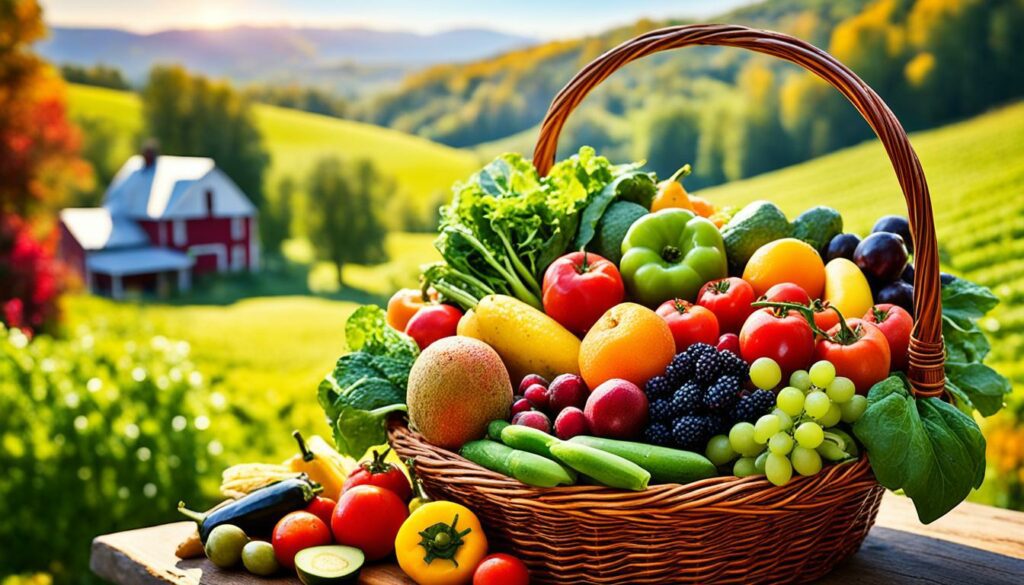
There are loads of reasons to use locally sourced ingredients:
Looking for fresh seasonal produce takes your meal to the next level. Here’s how to find the best fruits and vegetables:
Areas with lots of farms offer a huge range of fresh food. This makes finding fresh produce for your meals much easier.
Picking the best ingredients is vital for your gourmet dinner’s taste:
Adding locally sourced and seasonal produce to your meal makes it better. It also shows you care about the environment and support local farmers.
Starting a great farm-to-table dining experience involves careful planning. You need a menu based on the season’s best farm produce. Add local wine and beer to your menu to up the experience. It’s key to know about your area’s soil and how the food grows. This helps make a menu that is both fresh and true to where it’s from.
For a true farm-to-table meal, your menu should be all about the season’s best. Use fresh ingredients that are in season for the best taste. A survey found that chefs in Nevada think the quality of ingredients is really important. They rate this higher than how the food looks or its size. This shows they care more about taste than anything else.
By changing your menu with the seasons, you show off the best food. This also keeps your menu exciting for people who come back. This idea fits with a report in 2016 that said people really like local, fresh food. It’s always a popular choice.
Pairing your dishes with local drinks makes your meals even better. It connects the food and drinks perfectly. This not only helps local wine and beer makers but makes your food’s story richer. Chefs in Las Vegas prefer local and known sources more than just organic food. They want their food to capture the sense of place.
Knowing how to pair food and drinks well is a skill. Match strong, earthy food with local beers. Light and fruity foods go with crisp, fresh wines. This makes the meal taste even better. Plus, it gives people a taste of your region’s best drinks and food together.
Starting a meal with local produce sets a wonderful tone. It brings a touch of the region’s richness to the table. It makes the meal feel more special. It also highlights the benefits of healthy and sustainable food choices.
Farm fresh salads burst with just-picked goodness. Imagine a spring salad with the finest fruits and romaine. It’s a hit with those watching their health. Then, there’s the wedge salad, blending iceberg wedges with cherry tomatoes and more. They make salads fun to eat.
A summer salad idea is mixing avocados and citrus on a napa cabbage bed. This mix is a flavour and texture party. It’s a farm-to-table treat for any diner.
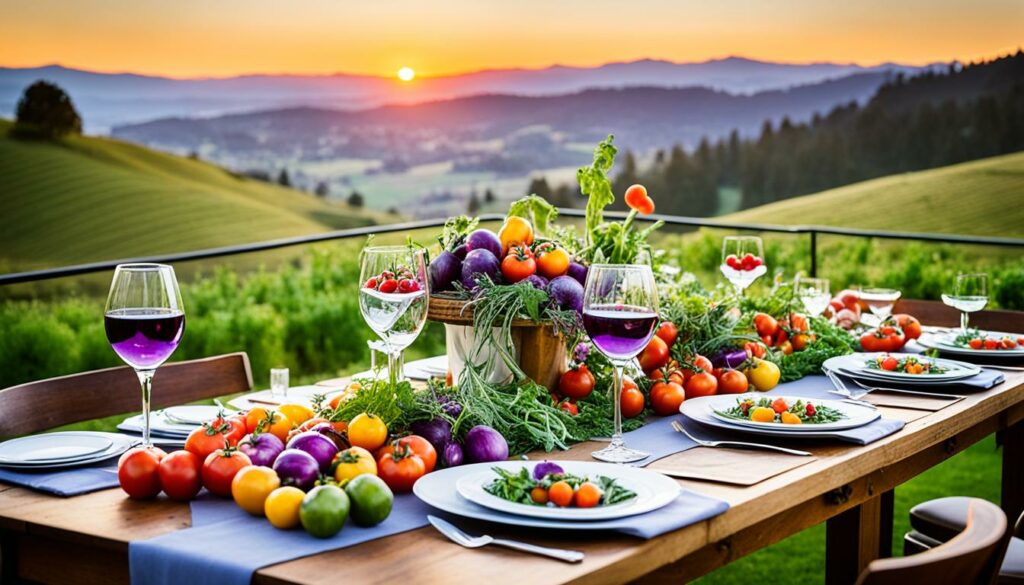
For a more filling start, go for soups or broths. A spring choice might be rigatoni with freshness like sugar snap peas. It also includes a lamb dish with artichokes for Italian cheer.
Don’t forget panko veal chops, fried with a creamy sorrel sauce. They bring something special. These dishes not only fill but also please the taste buds. The menu becomes a memorable adventure in farm-fresh dining.
Using local produce in main course meals is very special. It makes every dish, from meat to vegan, unforgettable. Local ingredients are key for a delightful and memorable gourmet dinner.
Celebrate farm-to-table dining with gourmet meat dishes. Choose from pasture-raised chicken to grass-fed beef for the best quality. Some top picks are:
Vegetarian and vegan fine dining shines with local vegetables. Their natural flavours stand out. Try these delightful dishes:
Seafood dishes highlight fresh fish and shellfish from local waters. This approach makes every meal special, for example:
With a focus on local gourmet produce, every dish is not just tasty. It also supports local agriculture all year round.
Making a dinner with organic farm produce can be exciting. It’s all about using local ingredients and special cooking methods. This way, you can make dishes that taste great and feel special. I’m sharing two amazing recipes that show how diverse organic produce can be.
Roast chicken with a crispy skin and a zesty taste is a thrill to serve. With baby carrots and bok choy, it’s more than a meal – it’s an experience. The chicken gets its zesty kick from Japanese seven-spice and a bit of citrus. This contrasts the tender, juicy meat. The baby carrots, known for their sweetness, mix well with the slightly bitter bok choy. They create a complete and pleasing dish.
Looking at the nutrition, chicken is high in protein, up to 43 grams per serving. It’s a filling choice for an organic dinner. With 30 minutes to marinate and 20 to roast, it fits well even on busy nights.

Twice smoked salmon with horseradish cream is a dish of elegance. Smoked twice, the salmon gains deep flavours. It pairs beautifully with the sharp horseradish cream. A sauce of dill and lemon cuts through the smoky salmon, adding balance. Each bite is a mix of great taste and texture.
This dish asks for planning – the salmon should chill for 8 hours to develop its flavours. Yet, the result is outstanding. Using local salmon ensures the dish is fresh and supports the environment. These are important for a mindful organic dinner.
| Dish Name | Main Ingredients | Preparation Time | Protein Content |
|---|---|---|---|
| Zesty Roast Chicken | Chicken, baby carrots, bok choy, Japanese seven-spice | 50 minutes | 43g |
| Twice Smoked Salmon | Salmon, horseradish cream, dill, lemon | 8 hours (chilling) + 30 minutes (smoking) | 25g |
Exploring farm-to-fork culinary experiences means using cooking techniques that highlight fresh, quality produce. Techniques like grilling, smoking, and roasting make farm-fresh food shine. They enhance the flavours, making the dining experience memorable.
Using different cooking techniques is key for farm-fresh foods. Grilling with wood chips adds a smoky flavour. Roasting makes vegetables sweeter with crispy outsides. These methods keep the essence of the food.
Sous-vide cooking is also great for precise cooking and keeping nutrients. Blanching and sautéing vegetables keeps them colourful and crispy. This adds to the dish’s appeal.
Herbs and spices are the secret to great taste in the farm-to-fork journey. Fresh herbs like basil and rosemary add scent. Spices like cumin and coriander bring depth and warmth.
A roast chicken with herbs and garlic becomes juicy and fragrant. A vegetable stew with bay leaves is rich and comforting. Herbs and spices amplify the farm’s ingredients, celebrating the meal.
Bringing a gourmet dinner to life with farm veggies is about more than just good food. It’s a nod to quality and staying green. Using local veggies in fancy recipes turns every meal into a unique and special occasion.
Chefs get creative with local veggies by using parts others might toss. They think up new ways to cook, adding exciting twists to dishes. Ever tasted roasted root veggies with rare spices or local cabbages that have been fermented?
Such flavours really grab your taste buds. In a study, chefs shared that they really care about top-notch produce. They gave a nearly perfect score to “product quality”. This shows how much they appreciate great ingredients.
| Quality Aspect | Importance Rating |
|---|---|
| Product Quality | 4.97 |
| Consistency of Quality | 4.48 |
| Product Freshness | 4.97 |
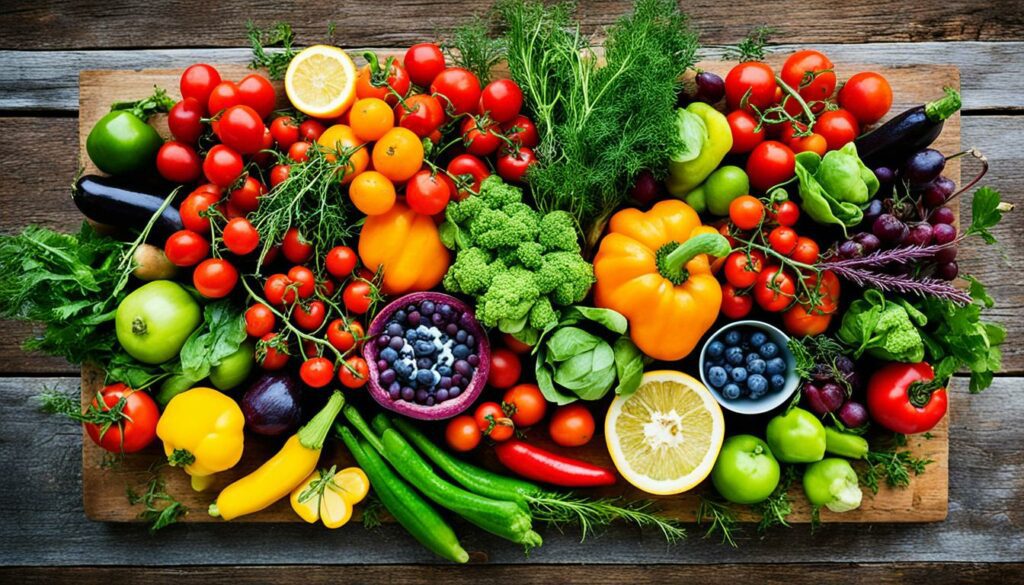
Fine dining often starts right at the farm. Chefs work closely with farmers to guarantee fresh, quality veggies for their high-class dishes. They crave produce that’s not only fresh but also locally sourced and easy to trace back to the farm.
Collaboration cuts down on waste, too. Companies like Simply Fresh lead the way, slashing salad packaging and recycling a whopping 250 tons yearly. Their actions promote a greener planet and make farm-fresh foods even more appealing.
Summing up, mixing unique recipes with local veggies and a focus on fresh farm produce creates top-notch dining experiences. It’s all about enjoying great food and knowing where it comes from.
Sustainable dining is now key for modern gourmet meals. The trend towards eco-friendly gourmet experiences shows a growing awareness in the culinary field. These choices look for local, seasonal foods to cut down on travel-related pollution. It’s both good for the planet and enjoyable for those who love food.
One big step we can take for the planet is focusing more on plant-based foods in cooking. Doing this cuts down on processed foods, which are big sources of sodium in the U.S. food supply. This change also means more fresh fruits and vegetables are used, making environmental sense.
Changes in our tastes and how connected the world is have led to more diverse food menus. Using local foods in creative ways is good for the environment and appeals to those looking for unique dishes. Restaurants like ARK in Copenhagen show this can win big, even receiving a Michelin Green Star recently.
Keeping portion sizes in check fights obesity and lowers food waste, helping our planet. Places like Silo in London lead the way by reducing their waste. They do this by not using packaged foods and composting what they don’t use.
Choosing the right wines also has a big impact on sustainable dining. Le Manoir aux Quat’Saisons serves mostly organic and biodynamic wines, fitting their sustainable ethos. In the U.S., Rhodora Wine Bar stands out by aiming to be waste-free through local sourcing and fair staff profit-sharing.
Pairing locally grown foods with ethical meat sources, such as at Otahuna Lodge in New Zealand, can make luxurious meals greener. These practices not only lower our food’s carbon footprint but also boost local areas. Moving forward, choosing sustainable dining options promises delightful and responsible experiences for all.
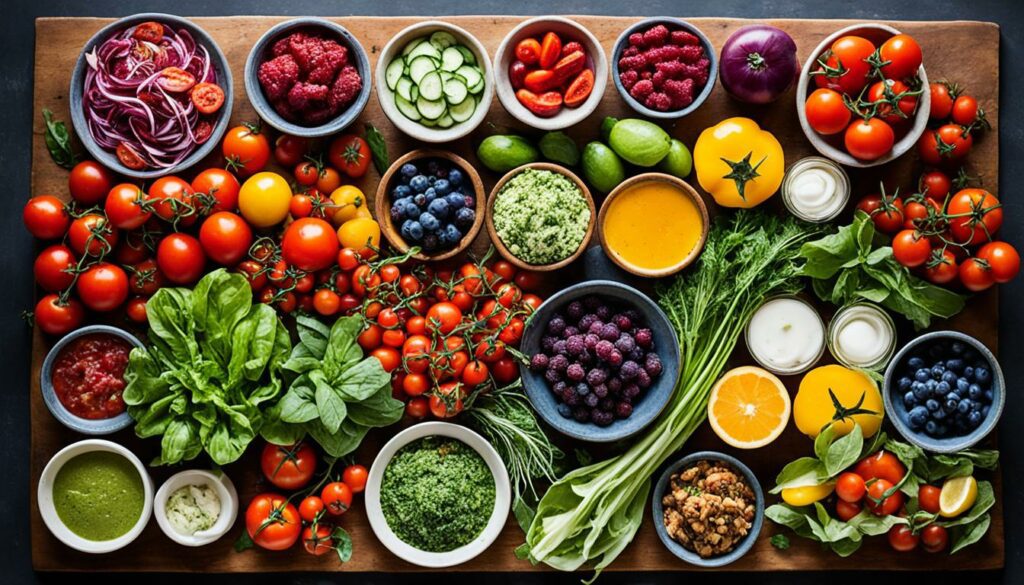
Choosing cooking with seasonal ingredients is a great way to improve your dishes. It keeps you in tune with nature. By using fresh, local produce, our meals not only taste better but are also more nutritious and eco-friendly.
Using farm-fresh food in your cooking has big health benefits. It’s packed with vitamins and minerals. This kind of food also supports the local economy and builds community connections.
Every season brings new ingredients for our meals. This makes our food exciting and varied. It also reduces our environmental impact. Plus, buying local means you can trust where your food comes from.
| Aspect | Fresh Ingredients | Processed Ingredients |
|---|---|---|
| Flavour | Superior, natural | Potential additives/artificial flavours |
| Nutritional Value | Rich in vitamins and minerals | Reduced nutritional content |
| Environmental Impact | Lower carbon footprint | Higher due to transportation/processing |
| Community Support | Supports local farmers and economy | Less direct local impact |
| Menu Adaptability | Requires adaptability | Consistent and uniform |
But, there are challenges to cooking seasonally. Sometimes fresh produce is hard to find. This means we need to be flexible with our recipes. Also, the cost of organic food can be more than processed food. But, the rewards are worth it, making cooking a fun adventure.
Cooking with seasonal food is more than the taste in the end. It’s about celebrating what each season brings. It lets us use our creativity in the kitchen. And it connects us to nature’s cycle in a beautiful way.
Making decadent desserts is a fantastic way to highlight your area’s best ingredients. You can use traditional recipes or put a new spin on things. Adding local ingredients makes the end result fresh and special.
Farm fruit tarts and pies show off the best of each season. Treats like peach cobbler and pecan pie are favorites, especially in the South. They remind us of the plentiful harvest times.
Buttermilk pie and transparent pie from Kentucky have interesting beginnings. They were originally “make-do pies” but are now seen as luxurious. These desserts make the most of fresh, local ingredients, providing a delicious ending to any meal.
Using local goodies in cakes and pastries brings delicious new flavours. In the South, chocolate cakes can be ultra-moist thanks to Duke’s mayonnaise. The famous coconut cake in Charleston is known for its layers, showcasing top-notch local ingredients.
Then, there’s the Japanese fruitcake and bourbon apple pie from Kentucky, which are unique and tasty. If you’re into something newer, the Coca-Cola cake is a hit from the 1990s. It proves that local ingredients can be used in fun and exciting ways.
Hosting a gourmet dining event in the countryside is a memorable experience. It mixes simple rural beauty with delicious food. To make it special, focus on the setting, the food, and fun things to do.
The dining decor sets the right tone for your event. Use rustic elements like wood and burlap. Add seasonal flowers. Lighting is important. Choose soft lights like fairy lights to create a cosy atmosphere. Details like matching tableware and comfy seats are key.
Entertainment makes a gourmet event more fun. For music, choose what fits the season. A local band or an acoustic singer can create a beautiful atmoshpere. For hands-on fun, consider food workshops. These can be about bread making or wine tasting. Working with local experts also adds to the event.
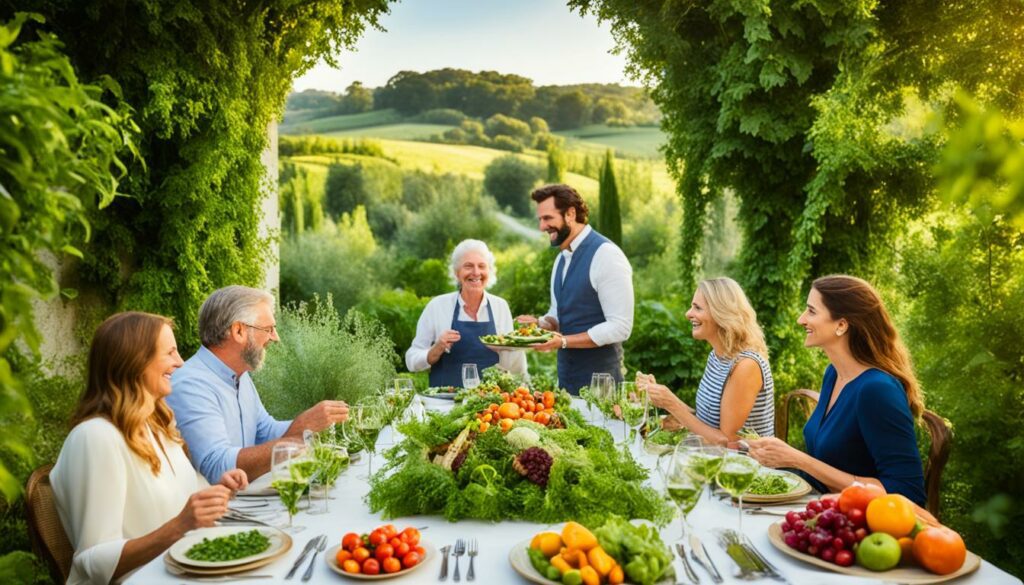
To host the perfect event, plan carefully. Think of everything, from where guests park to the temperature. Don’t forget about the rules. Starting small and growing can help you learn as you go. Working with others in the community can add to your event’s charm and success.
Bringing farm-to-table practices into our kitchens improves meal quality and helps the planet. When we buy from local sources and use eco-friendly methods, our food gets fresher. This also lowers the release of harmful gases and opens up how our meals are made.
To cut down on kitchen waste, smart buying and storing food are the first steps. Using every bit of the produce adds unique tastes and textures to our dishes. This method fits well with getting food directly from farmers to our tables.
Composting and recycling are key in being eco-friendly in the kitchen. Making compost from food scraps helps gardens and cuts down on waste in landfills. Proper recycling of items like glass and paper also helps them get reused.
By choosing farm-to-table ways, we help American farmers and make the food world greener. The joy of using fresh, local ingredients can’t be beaten. It not only makes meals wonderful but also helps the environment.
Exploring gourmet dining with local food marks a big step towards being both sustainable and high quality. The top-notch quality of products in Nevada, like we found in this study, shows why local produce matters. Chefs value this produce for its quality, giving it top scores for freshness and quality.
Buying directly from local farmers saves money and supports the growers directly. Chefs love using these ‘noncommercial’ foods because they taste better and are unique. This shows the importance of local food in fancy dishes. Variety and strong chef-farmer relationships help create a future for food that’s good for everyone.
This movement of food straight from the farm to the plate is more than just popular; it’s here to stay. It boosts the local economy, helps farmers, and offers healthier food. Places like Chez Panisse began this in the 1970s. Now, many cities across America have caught on. It’s more than a food trend; it’s a way of eating that’s good for us and our planet. It lets us enjoy local food and join a tasty adventure together.
Locally sourced ingredients offer fresher produce and support local economies. They also reduce the environmental impact of shipping food long distances. This makes gourmet dishes taste better, celebrating the region’s bounty.
Visiting local farmers’ markets is a great way to start. You can also join community-supported agriculture (CSA) groups. Don’t forget about growing your own in a home garden. These options allow you to cook with high-quality, fresh farm produce.
Look for produce that is ripe, vibrant, and fragrant. These qualities ensure the best taste. Using fresh and organic farm produce makes your dishes even more flavoursome.
Create a menu that shows off the freshest ingredients of the season. Pair your dishes with local drinks to bring out their flavours. Knowing about the terroir and seasons in your area helps you create a refined menu.
Farm fresh salads with just-picked greens and vegetables are a good choice. You can dress them with artisanal vinaigrettes. Hearty soups and broths made from local harvests and herbs also offer unique flavours.
Main courses can include succulent meat dishes, vegetarian options, or seafood meals. Especially with local, seasonal produce, each dish can delight the palate. Skill and care in cooking can make any dish special.
Zesty roast chicken with baby carrots and bok choy is a great choice. So is twice smoked salmon with horseradish cream. Both recipes show how good organic farm produce can be.
Use different cooking methods to showcase fresh farm ingredients. For example, grilling with wood chips adds a smoky taste. Roasting makes food sweeter and more intense. Adding herbs and spices can make the meal even better.
You can try new recipes that use less common vegetables. Or you can cook them in a different way. With creativity, you can turn local farm produce into amazing dishes.
Sustainable dining is about using local, seasonal, and ethically sourced food. It’s an eco-friendly and indulgent way to enjoy a meal. It shows care for the environment and good food.
Using seasonal produce means your dishes are fresh, healthy, and good for the planet. It also inspires new recipes. You get to feel and taste nature’s rhythms, making cooking more meaningful.
Farm fruit tarts, pies, cakes, and pastries are great for desserts. They use fresh, local ingredients to sweeten the end of your meal. These treats truly celebrate the local agriculture.
For a countryside event, focus on a rustic feel with your decor. Think natural table settings and soft lighting. Consider adding live music, workshops, or wine tastings for fun and engagement.
To reduce waste, use every part of the produce when cooking. Proper storage helps too. Composting and recycling can also make your kitchen eco-friendly. This helps in cooking sustainably.